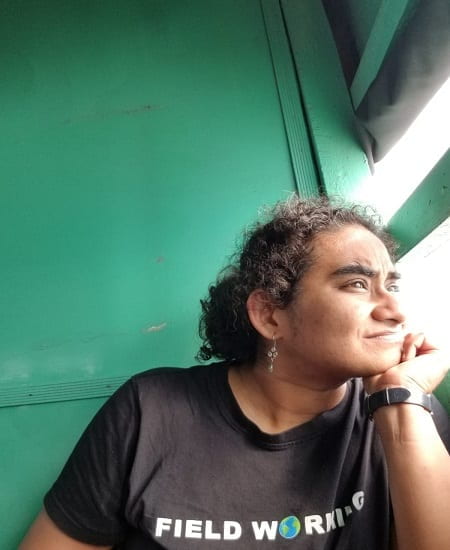Last year, thanks to a Sigur Center research stipend, I spent my summer on the river island of Majuli in the Indian state of Assam. In late May, my friends in the Mishing village of Sitadhar invited me to join them in celebrating Dobur, the festival that marks the end of the harvest and the beginning of monsoon. We gathered in a bamboo hut in the middle of the field, and offered thanks to the deities of Donyi Polo, the indigenous religion that several of the villagers observe. Not far from where we sat, ran the Luhit, a tributary of the Brahmaputra, that connects these villages to the town of Lakhimpur to the north of Majuli island. Between the prayer and the annual feast, I walked along the banks of the Luhit, observing the rising waters and the swift current. That day cyclone Mora hit the coast of Bangladesh, and while Majuli was not hit by the storm itself, heavy rain pelted down all night and for most of the next day. Soon after, the north-east monsoon hit the shores of the island. I was scheduled to do some archival work in Delhi and as I headed from Majuli to the port of Nimati in Jorhat town, the currents got stronger and the river tore away the dock where we were supposed to land. Our boat was forced to make an emergency landing. When I called my friends in Majuli that afternoon, they seemed alright. The rivers were full, but they were simply wrapping up the harvest. But the next day, Luhit overflowed its banks and its waters ran ferociously into their fields, wreaking havoc. The Ganggin where we had prayed collapsed, shacks used to keep cows and pigs were damaged and several farmers lost their crop.
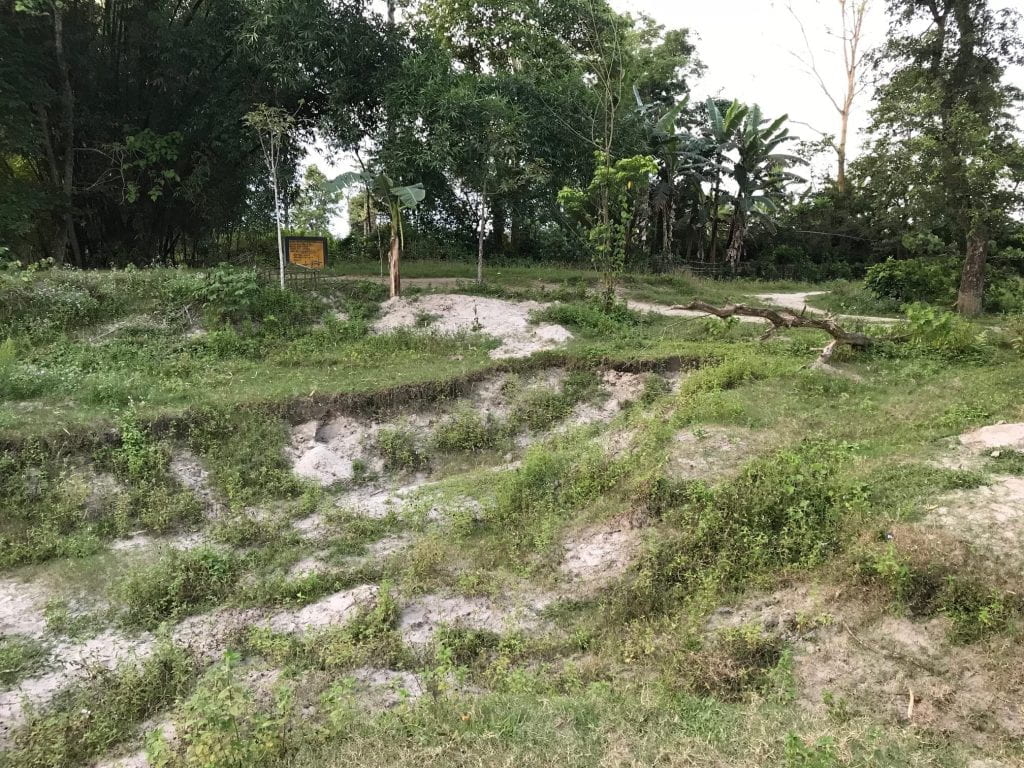
This May, when I visited Majuli—again, in time for the festival—I was asked if I could spend some time helping the villagers set up their new Ganggin. Built close to where the old bamboo structure had stood, the new Ganggin, made of concrete conveyed a sense of sturdiness that seemed to assure them. The grounds we had very casually walked across only in the previous visit now had shallow craters. Large chunks of earth had been carried away, and even if the river had deposited a fresh layer of silt on these grounds, the uneven land was not as conducive to farming as it had once been. One of the farmers told me that he had not finished harvesting his crop when the floods hit. He had lost over 6000 rupees worth of rice, and had also been unable to salvage the corn he grew for personal use.
This year, working with his wife, daughter-in-law and son, this farmer planned to harvest faster than he had the previous year. But as the day for Dobur came closer, he also had to finish building and decorating the Ganggin. The concrete structure had no paint and it looked pretty stark amid the lush green fields. Hoping to brighten its facade, he asked me to make him some flags with coloured paper. The cheery paper, he hoped, would help people who shared this Ganggin forget that they had lost so much only a year ago, and instead remind them to celebrate the new place of worship and the good harvest.
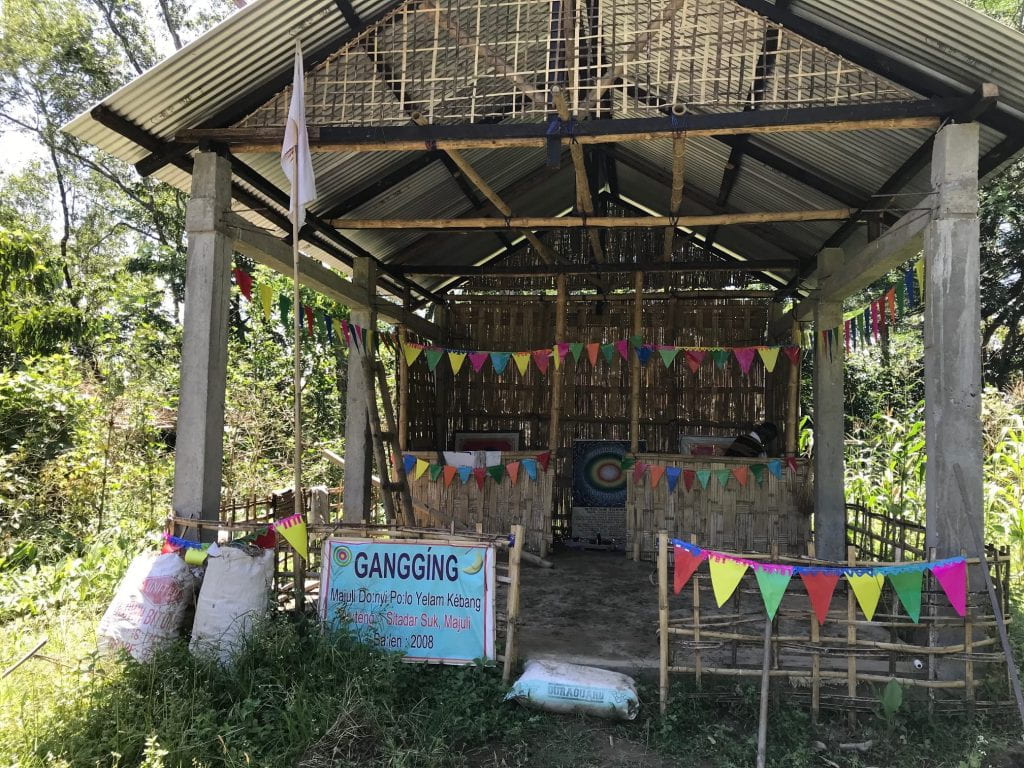
I—and the good friend whose help I conscripted—spent a good three days making paper flags. Unable to find good crafts material in Majuli, we planned a trip to the Gar Ali market in the town of Jorhat, where we picked up brightly colored paper, scissors, and tape. Back in Majuli, we wandered around the Goramur market looking for the right kind of chord to hold the flags together. As we sat sipping tea and cutting flags, we invited several questions from curious onlookers. After three days of cutting and tying and more cutting and typing we had flags of three different sizes and styles ready. On the morning of the festival, we worked with the farmer and his friends to decorate the place of worship. After the prayer, he gave us a locket with the Donyi Polo sign on it as a token of his gratitude and friendship.
The day after the festival most of my friends went back to the fields. The festival had come and gone, but the harvest was not quiet over. They worked with an eye on the sky, watching out for signs of the monsoon. I headed to Delhi for archival work, but called to check in when I heard that the monsoons had hit Assam. “This year, we had no trouble from the rain,” one of my interlocutors said. “In fact, we are going to be in trouble because I fear we did not have enough rain.”
I write this blog to call attention to the myriad ways in which people make life amid the erratic climatic patterns in the Brahmaputra Valley. Last year, the rains were heavy in Majuli, and the floods devastating. But where land wasn’t excavated by the flooding waters, the harvest was good. This year, the rains were not as heavy, and the floods not as fierce. But the farmers might have to be concerned about the crop. This uncertainty may not seem entirely uncommon; after all, farming communities have always had to deal with differing patterns of rainfall.
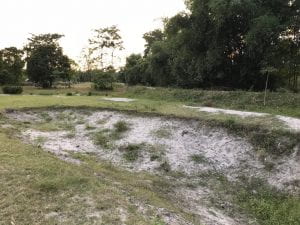
But the excavated craters in their fields tell a different story. When Majuli becomes subject to devastating floods, it loses anything between 3.1 square kilometers to 8.5 square kilometers of land (Lahiri and Sinha 2014). Sometimes—like in the year 2005—entire villages have been washed away. Thus, uncertainty in Majuli is not simply a product of capricious monsoonal rain; it is tempered by the erosion of lived places. My dissertation examines how the Mishing draw on their religious ethical ideals, local knowledge, and other resources available to them to build a life amid erosion. As I get ready to wind up my summer, and start a whole year of fieldwork in Majuli two questions come up for me: What will it take for the bureaucratic institutions involved in the prevention of erosion in the Brahmaputra valley to begin seeing erosion, the changing rainfall and the floods as connected phenomena? In other words what will it take for them to recognize these events as part of the global phenomenon called climate change (Ghosh 2016)? When they intervene will they learn from local efforts or will the techno-scientific machinery of the state efface local knowledges and practices that allow local communities to make life in this damage planet (Gan et al. 2017)?
References:
Gan, Elaine, Anna Tsing, Heather Anne Swanson, and Nils Bubandt. 2017. Arts of Living on a Damaged Planet. Minneapolis: Minnesota University Press.
Ghosh, Amitav. 2016. The Great Derangement: Climate Change and the Unthinkable.Chicago: Chicago University Press.
Lahiri, Siddharthand Rajiv Sinha. 2014. “Morphotectonic Evolution of the Majuli Island in the Brahmaputra valley of Assam, India Inferred from Geomorphic and Geophysical Analysis.” Geomorphology227(2014):101-111.
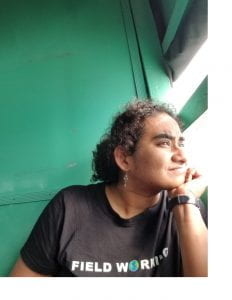
Shweta Krishnan is a PhD Candidate in the department of Anthropology at George Washington University. Her research interests include the anthropology of religion, science and the environment. Her current project explores religious revival amid riverine erosion in the island of Majuli, Assam.
